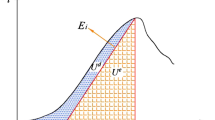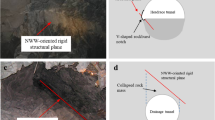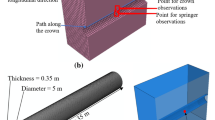Abstract
Much research has been conducted on the influence of rock burst mechanisms and temperature on the mechanical properties of hard rock while research on the effect of temperature on rock bursts is scarce. Therefore, this paper focuses on Rock Burst Proneness Index tests and acoustic emission (AE) tests under the action of high temperature. It was found that the Rock Burst Proneness Index and the AE energy will rise as the temperature rises. It means that the degree of rock burst is increasing instead of decreasing with rising temperature. The research results revealed the temperature effect of rock burst in long deep tunnels under a certain thermal stress condition, which is helpful for explaining the rock burst disaster in tunnels at high ground temperature.








Similar content being viewed by others
References
Alexeev AD, Revva VN, Alyshev NA et al (2004) True triaxial loading apparatus and its application to coal outburst prediction. Int J Coal Geol 58(2):245–250
Andersson JC, Martin CD (2009) The Aspo Pillar Stability Experiment: part II-rock mass response to coupled excavation-induced and thermal-induced stresses. Int J Rock Mech Min Sci 46(5):879–895
Cavagnaro M, Brulard J (1997) Aerodynamic and thermal investigations for the new lyon/turin cross-alpine rail link. Tunn Undergr Space Technol 12(3):377–384
Chen BR, Feng Gl et al (2013a) Analysis of microseismic characteristic and rock burst risk during TBM excavation under deeply buried tunnel. Disaster Adv 6(s1):122–128
Chen GQ, Li TB, Yin HY et al (2013b) Brittle characteristics of granite under temperature action. Disaster Adv 6(13):345–355
Chen GQ, Li TB, Gao MB et al (2013c) Deformation warning and dynamic control of dangerous disaster for large underground caverns. Disaster Adv 6(s1):422–430
Cheon DS, Jeon S, Park C et al (2006) An experimental study on the brittle failure under true triaxial conditions. Tunn Undergr Space Technol 21(3):448–449
Cheon DS, Jung YB, Park ES et al (2011) Evaluation of damage level for rock slopes using acoustic emission technique with waveguides. Eng Geol 121(1):75–88
Diederichs MS, Kaiser PK, Eberhardt E (2004) Damage initiation and propagation in hard rock during tunneling and the influence of near-face stress rotation. Int J Rock Mech Min Sci 41(5):785–812
Dou LM, Lu CP, Mu ZL (2009) Prevention and forecasting of rock burst hazards in coal mines. Min Sci Technol 19(5):585–591
Feng XT, Hudson JA (2011) Rock engineering design. CRC Press, Boca Raton
Feng XT, Pan PZ, Zhou H (2006) Simulation of the rock microfracturing process under uniaxial compression using an elasto-plastic cellular automaton. Int J Rock Mech Min Sci 43(7):1091–1108
Frid V (2001) Calculation of electromagnetic radiation criterion for rockburst hazard forecast in coal mines. Pure appl Geophys 158(5):931–944
Frid V, Vozoff K (2005) Electromagnetic radiation induced by mining rock failure. Int J Coal Geol 64(1):57–65
Ganne P, Vervoort A, Wevers M (2007) Quantification of pre-peak brittle damage: correlation between acoustic emission and observed micro-fracturing. Int J Rock Mech Min Sci 44(5):720–729
He MC, Miao JL, Feng JL (2010) Rock burst process of limestone and its acoustic emission characteristics under true-triaxial unloading conditions. Int J Rock Mech Min Sci 47(2):286–298
Huang RQ, Wang XN, Chan LS (2001) Triaxial unloading test of rocks and its implication for rock burst. Bull Eng Geol Environ 60(1):37–41
Hudson JA, Stephenson O, Anderson J et al (2001) Coupled T–H–M issues relating to radioactive waste repository design and performance. Int J Rock Mech Min Sci 38(1):143–161
Jiang Q, Feng XT, Xiang TB (2010) Rock burst characters and numerical simulation based on a new energy index: a case study of tunnel under 2,500 m depth. Bull Eng Geol Environ 69(3):381–388
Jiang Q, Feng XT, Chen J et al (2013) Estimating in situ rock stress from spalling veins: a case study. Eng Geol 152(1):38–47
Kidybinski A (1981) A bursting liability indices of coal. Int J Rock Mech Sci Geomech Abstr 12(2):295–304
Koyamaa T, Chijimatsub M, Shimizuc H et al (2013) Numerical modeling for the coupled thermo-mechanical processes and spalling phenomena in Äspö Pillar Stability Experiment (APSE). J Rock Mech Geotech Eng 5(1):58–72
Lei XL, Masuda K, Nishizawa O et al (2004) Detailed analysis of acoustic emission activity during catastrophic fracture of faults in rock. J Struct Geol 26(2):247–258
Li XQ, Dai LX (2011) Cooling technology for construction of high earth temperature section of a diversion tunnel. Water Resour Hydropower Eng 42(2):36–41
Li DJ, Jia XN, Miao JL et al (2010) Analysis of fractal characteristics of fragment from rockburst test of granite. Chin J Rock Mech Eng 29(s1):3280–3289
Li SJ, Feng XT, Li ZH (2012) In situ monitoring of rock burst nucleation and evolution in the deeply buried tunnels of Jinping II hydropower station. Eng Geol 137(6):85–96
Lin QX, Liu YM, Tham LG (2009) Time-dependent strength degradation of granite. Int J Rock Mech Min Sci 46(7):1103–1114
Liu QS, Xu XC (2000) The analysis of damage of brittle rock under temperature. Chin J Rock Mech Eng 19(4):408–411 (in Chinese)
Lockner D (1993) The role of acoustic emission in the study of rock fracture. Int J Rock Mech Mining Sci Geomech Abstr 30(7):883–899
Marechal JC, Perrochet P, Tacher L (1999) Long-term simulations of thermal and hydraulic characteristics in a mountain massif: the Mont Blanc case study, French and Italian Alps. Hydrogeol J 7(4):341–354
Pan PZ, Feng XT, Huang XH (2009) Coupled THM processes in EDZ of crystalline rocks using an elasto-plastic cellular automaton. Environ Geol 57(6):1299–1311
Rybach L, Pfister M (1994) Temperature predictions and predictive temperatures in deep tunnels. Rock Mech Rock Eng 27(2):77–88
Singh SP (1988) Bursting energy release index. Rock Mech Rock Eng 21(1):149–155
Song DZ, Wang EY, Wang C (2010) Electromagnetic radiation early warning criterion of rock burst based on statistical theory. Min Sci Technol 20(5):686–690
Vinciguerraa S, Trovatoa C, Meredith PG (2005) Relating seismic velocities, thermal cracking and permeability in Mt. Etna and Iceland basalts. Int J Rock Mech Min Sci 42(7):900–910
Xu XL, Kang ZX, Ji M (2009) Research of microcosmic mechanism of brittle-plastic transition for granite under high temperature. Proced Earth Planet Sci 1(1):432–437 (in Chinese)
Zhang XC, Wang JQ (2007) Research on the mechanism and prevention of rock burst at the Yinxin gold mine. J Chin Univ Min Technol 17(4):541–545
Zhang ZZ, Gao F, Liu Z (2010) Research on rock burst proneness and its microcosmic mechanism of granite considering temperature effect. Chin J Rock Mech Eng 29(8):1591–1602 (in Chinese)
Zhang CQ, Feng XT, Zhou H, Qiu SL (2012) Case histories of four extremely intense rock bursts in deep tunnels. Rock Mech Rock Eng 45(3):275–288
Acknowledgments
The authors thank the Cultivating Program of excellent innovation team of Chengdu University of Technology (No. HY0084). This work was supported by the National Natural Science Foundation of China under Grant Nos. 41230635, 41002110 and 41272330 and also by the West Traffic Construction Science and Technology Project of the Ministry of Transport (No. 20113188051090).
Author information
Authors and Affiliations
Corresponding author
Rights and permissions
About this article
Cite this article
Chen, G., Li, T., Zhang, G. et al. Temperature effect of rock burst for hard rock in deep-buried tunnel. Nat Hazards 72, 915–926 (2014). https://doi.org/10.1007/s11069-014-1042-6
Received:
Accepted:
Published:
Issue Date:
DOI: https://doi.org/10.1007/s11069-014-1042-6




